Billingham 207 Camera Bag Review:
The Billingham 7 Series bags are for those who need a little more breathing room for say larger gear or just more gear in general. There are currently two in the series: the Billingham 207, and the 307 (the 107 has been discontinued). Both offer the same features with only the width of each bag being different. The 307 is the largest, and you guess it, the 207 is the smallest. Thanks to Billingham, I was able to get a 207 in to review, and here are my thoughts on it.
Billingham 207 Camera Bag Build Quality:
Billingham has been in the camera bag making business since the 1970s, and there are several big reasons why they’ve stood the test of time. One of these reasons is there bags are made extremely well. The Billingham 207, for instance, is beautifully stitched. Rich materials, such as, fine grain leather, and solid brass fixings, are not only used throughout the entire bag, they are put together very neatly and professionally. In other words, there isn’t any unevenness in for instance, the way a piece of fabric is attached. There aren’t any loose threads. The bag is immaculate. One may think perfect fit, and craftsmanship are a given when you’re paying a lot for a bag but I’ve used my fair share of bags that cost a lot but don’t necessarily offer the quality one would expect. Taking everything into account, the 207’s overall quality is simply up there with the best.

↑ The Billingham 207 in khaki FibreNyte/chocolate leather.
Of course, being one of the best often means the price does go up a bit, and well, let’s just say the 207 isn’t a cheap bag but as they often say, you get what you pay for. In this case, you’re paying for a bag that won’t ever quit on you. The Billingham 207 (B&H Photo/Amazon) is built to last years, and year even under hard usage. I’ve think I’ve accumulated a lot of Billingham bags over the years, and each one is a user. I do not baby my bags. I drag them with me through all types of weather, and they’ve all had more than their fair share of bumps, and scrapes. To me, cameras bags are designed to protect my camera gear, so I am going to use them for that exact purpose. My oldest bag is a 20+ year old Hadley that looks terrible on the outside but to this day, it’s still one of my daily users.
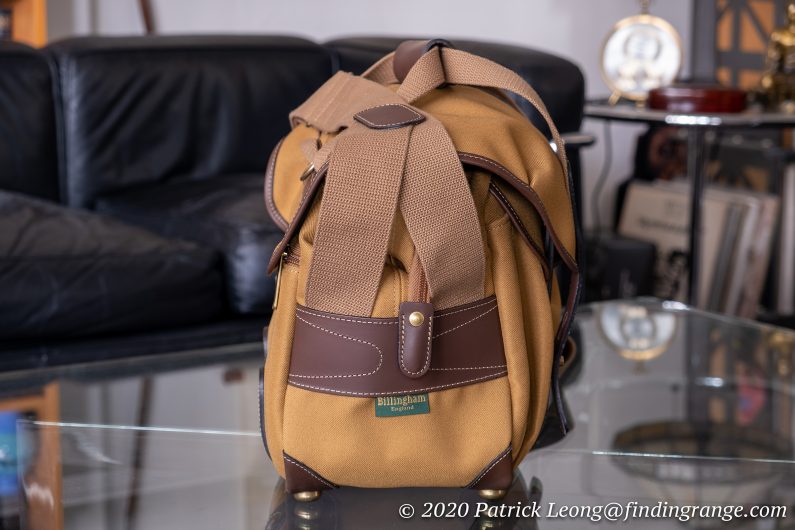
↑ The side of the Billingham 207.
In addition to its longevity, the 207 offers some of the best protection that you can get for your camera gear. It starts off with the outside, which is made exclusively with Billingham’s synthetic material, FibreNyte. Billingham’s traditional canvas is excellent but FibreNyte is more durable, lighter, and more fade resistant all while giving you a look and feel that is very similar to canvas. If there is an option, it’s actually my go-to choice. Color wise, the 207 comes in black fibreNyte/black leather, sage FibreNyte/chocolate leather or khaki FibreNyte/chocolate leather, which is what you see here.
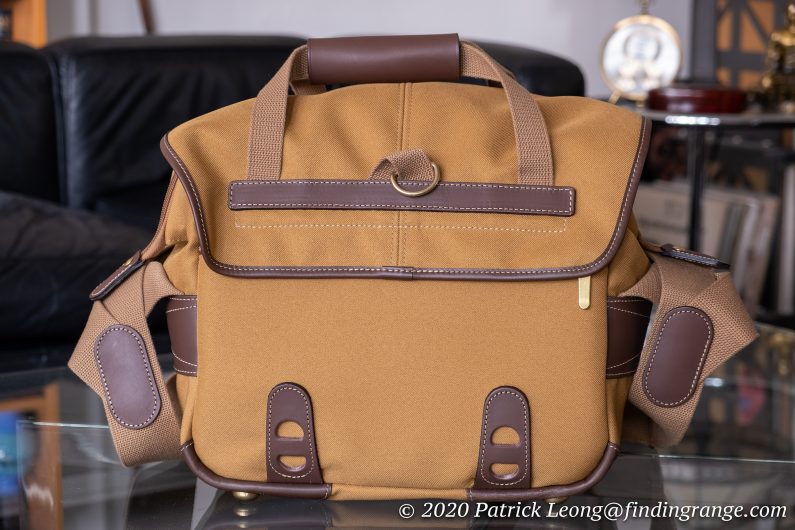
↑ The back of the Billingham 207.
The outer material is also designed to handle some seriously rough weather. All Billingham bags in general have, in my opinion, some of the best weather protection out there, especially against the wet. I’ve actually had puddles form on top of several of my bags during some big tropical rainstorms without anything getting through. There wasn’t even a hint of dampness inside the bag.

↑ Here’s a close up of the FibreNyte, stitch work, and brass clogs.
The reason these bags like the Billingham 207 (B&H Photo/Amazon) are so great in bad weather is because there’s three layer waterproofing here: the 207’s fabric is bonded to a layer of butyl rubber for excellent wear and weather protection. In addition, the main flap has a central, double layered, waterproof seam, which also extends over the ends of the bag to provide excellent protection against the elements. Bottom line is if you feel the urge to take pictures, rain, sleet and snow will not stop you. Your gear, and the entire contents inside the bag will stay completely dry. To top it all off, you never have to apply waterproofing to the 207 either.
As for protection against bumps and impacts, you’re also covered with the 207 because the padding in here is some of the best I’ve seen. It’s almost overkill but in a good way because this is how I look at it: one of the main purposes of a camera bag is to protect my gear, which can be, often times, very expensive to repair or replace. When you open the 207, all four sides are protected with very thick padding. The bottom has an extremely thick, reinforced pad as well. It’s a 25mm thick piece of foam attached to a wooden base. It’s also removable, so it can be replaced, if you lose it or if it gets damaged.
As for the dividers, they are just as excellent as the padding inside the Billingham 207. There are two included: a SuperFlex 9-15, and a SuperFlex Flap. There is actually no base to the SuperFlex divider 9-15 because it’s designed to work with the padded base inside the 207. All the dividers have velcro, so you have the flexibility of attaching them all over the main compartment.
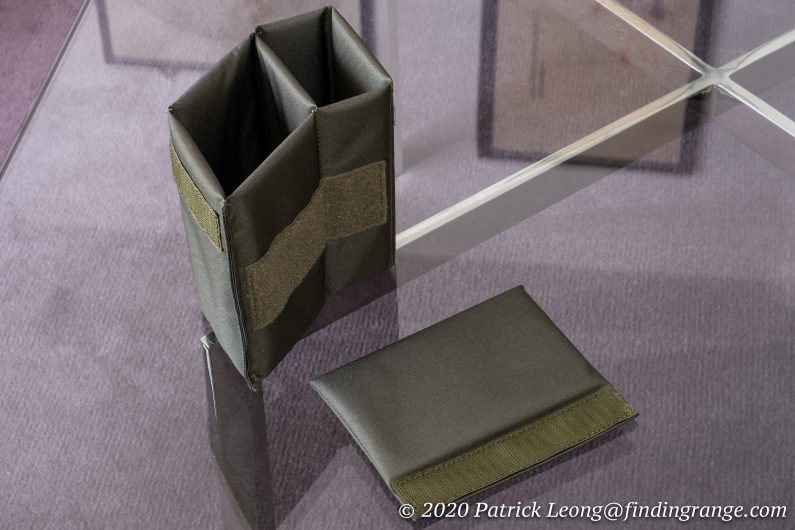
↑ The Billingham 207 comes with a Superflex 9-15, and a Superflex flap.
Billingham 207 Camera Bag Carrying Capacity:
So, now that we’ve discussed the build quality, let’s look at what will actually fit inside the Billingham 207. As I mentioned earlier, the 207 is smaller in width than the 307 but with that said, it’s still a 7 Series bag, which means it can hold quite a lot of gear. In one of its basic configurations, it can hold a full frame DSLR with two pro level zooms, and a flash. Of course you can change up the way you configure the dividers and hold more. You can even purchase another Superflex divider, and carry more lenses. Obviously it all depends on your gear (size), and how you choose to configure the main compartment.
To access the main compartment, you lift the main flap where you’ll then be greeted with a main compartment zip. Once you unzip the 207, you spread it open, and it’ll stay opened thanks to the Billingham PressTop feature. There are two specially shaped fiberglass, and aluminum wands that shape the opening into a wide rectangle for easy access. It’s like one of those old-fashioned doctor’s bags. In my opinion, this is one of the best ideas ever for a camera bag that is designed to hold larger or more gear in general. It makes accessing the bag so much easier during shoots, for example.
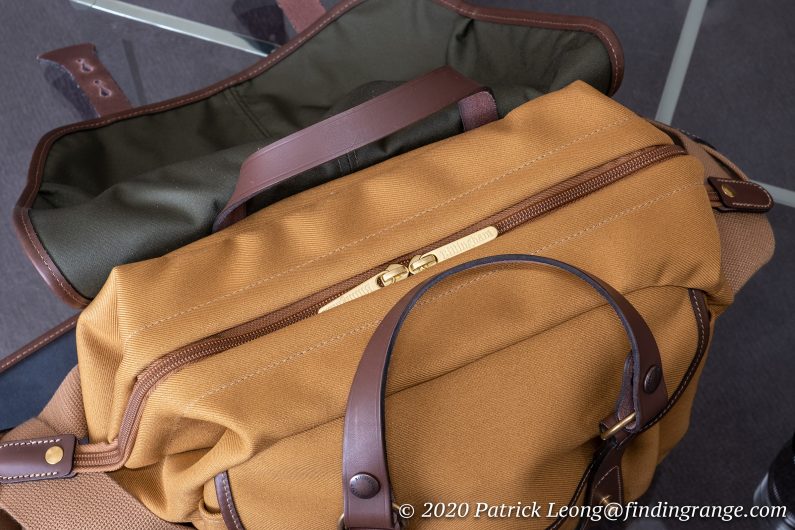
↑ In addition to the main flap, there’s a zip enclosure as well.
When I’m on location, I place the Billingham 207 on the ground, spread it open, and simply work right out of the bag. It’s exactly what I’ve been doing with my 307. With such a wide opening that remains opened until I decide to close it, it’s easy to work out of, and do things like change lenses. I don’t have to juggle around with lenses in my hands because I don’t have anywhere to put them. It’s worth noting that this bag will not roll over either, so it’s a stable platform. It’s flat on the bottom, and there are four solid brass feet.
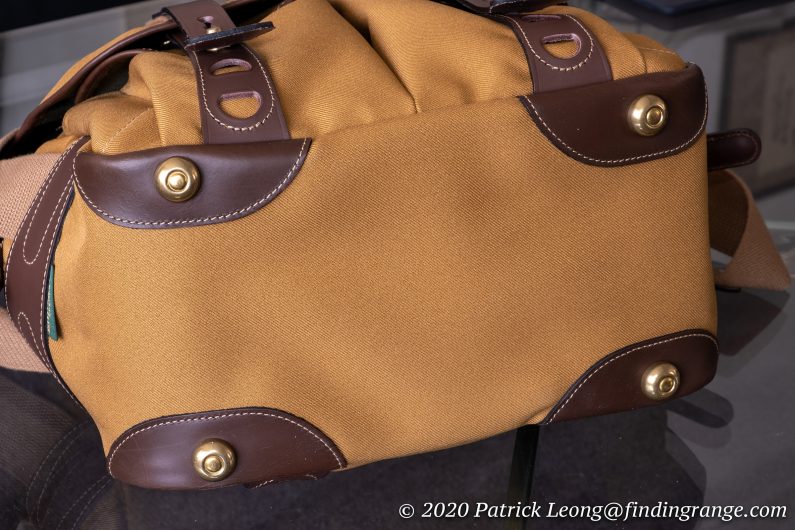
↑ There are solid brass feet on the bottom of the bag.
Another point worth mentioning, which I’ll talk a bit more about below as well is that there are actually two sets of top handles to this bag. There’s one on top of the main flap, and one set of thick leather handles when the flap is lifted. This might seem redundant but I find the leather handles to be one of the best features of the 207 because often times, I move from one location to another or I have to move my bag into another room. As I just mentioned earlier, I work out of the bag, and therefore, just leave it open. Instead of zipping the 207 up, and securing the flap just to use the top handle, I can just grab those leather handles, and quickly move the bag.
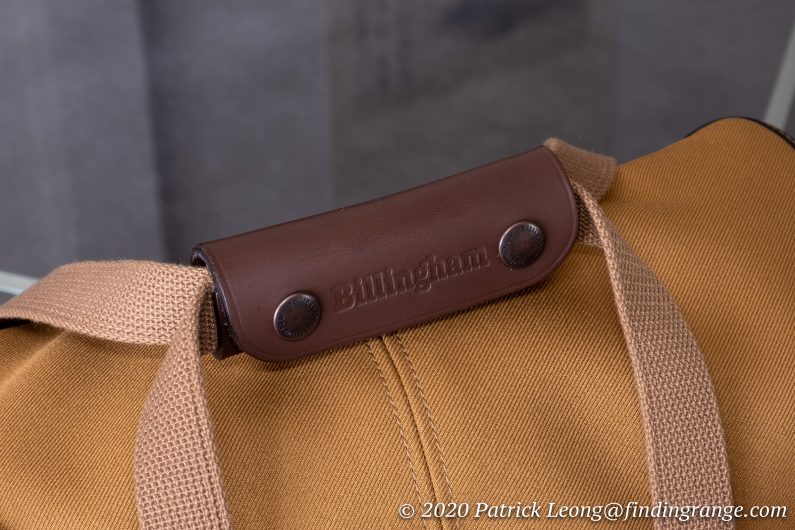
↑ There’s a top handle on top of the main flap.

↑ There are additional handles for your convenience, once you open the main flap.
So, let’s get back to the main compartment real quick. I have a couple of photos below of it, so you can see how I would use it. I also have a picture of my 307’s main compartment, just so you can compare.

↑ The empty main compartment of the Billingham 207.
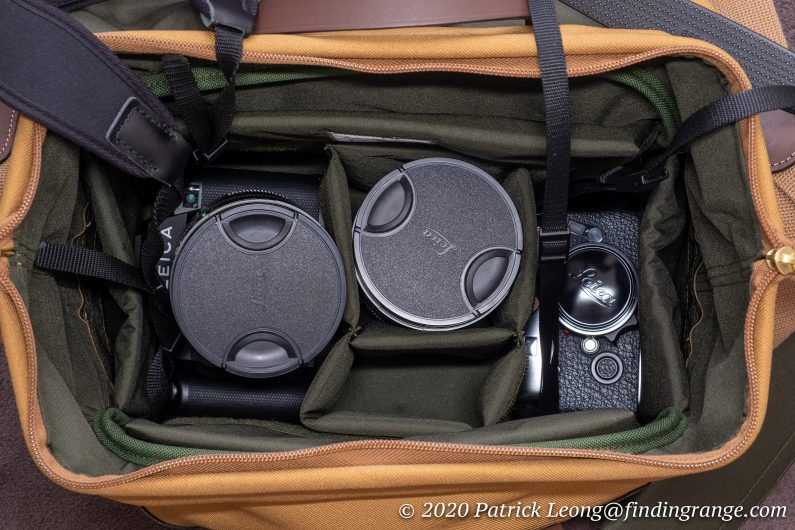
↑ In this photo from left to right: Leica SL2 with Summilux-SL-50mm f1.4 ASPH, Vario-Elmar-SL-24-90mm f2.8-4 ASPH, and a Leica M6 TTL Millennium with Summicron-M 35mm f2 ASPH Black Paint attached.
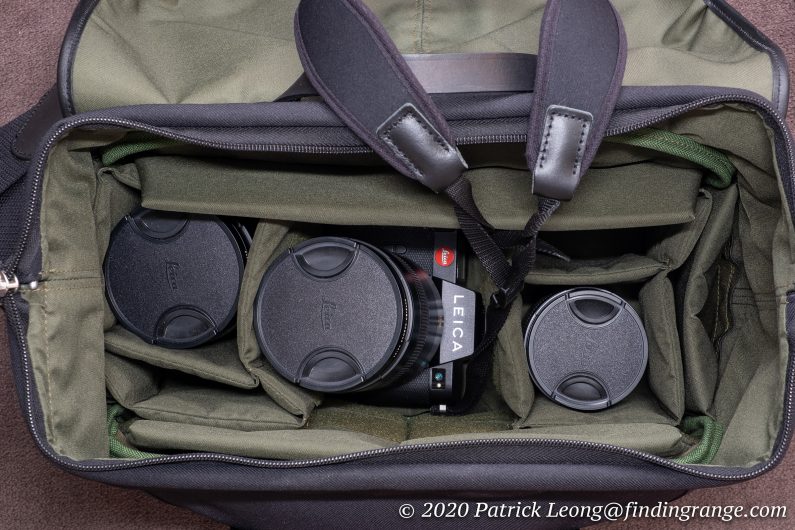
↑ Here’s a photo of my Billingham 307’s interior, so you can compare.
If you need to store other stuff besides your main gear, there are a lot of useful pockets in the Billingham 207 (B&H Photo/Amazon). There are two dump pockets in the front of the bag secured by a buttoned flap that hold quite a lot of stuff. I usually throw my chargers, batteries, and Pocket Wizards in them. There’s enough room for other items like filters or extra batteries as well. There’s a zippered pocket on the back that you has enough room for my iPad Pro 9.7″ but I usually just throw my model release forms or any documents I might have with me in there. Inside the main compartment, you’ll also find a pocket that will fit a tablet. There are also two more pockets on the opposite side. If you need even more room, you can add the Billingham Delta Pocket to either or both ends of the bag.
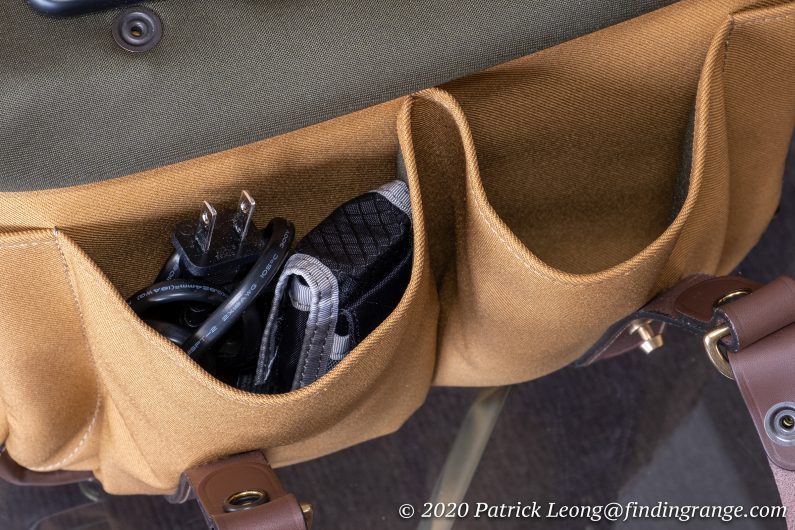
↑ The front dump pockets.
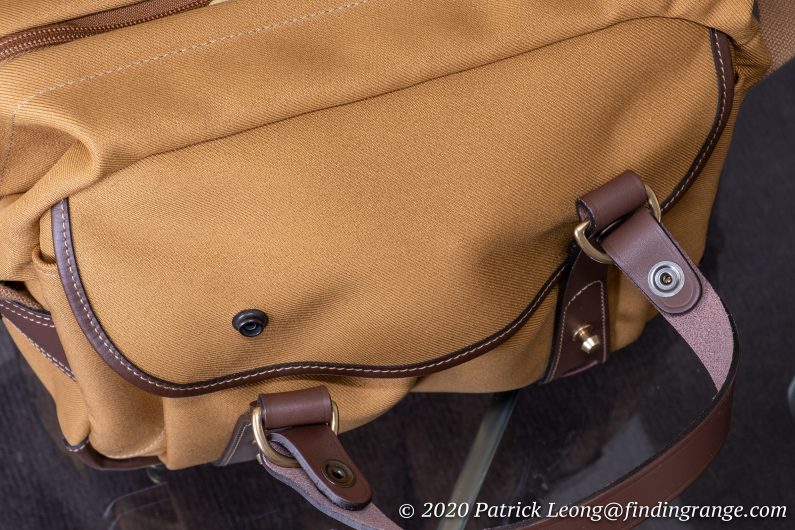
↑ The front dump pockets of the Billingham 207 are secured with a press stud enclosure.
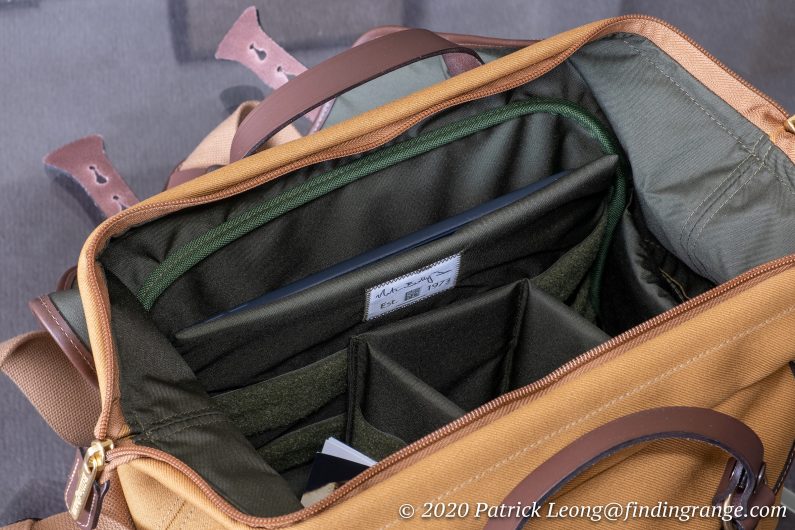
↑ There’s a back pocket in the main compartment, which I can store my Apple iPad Pro 9.7.
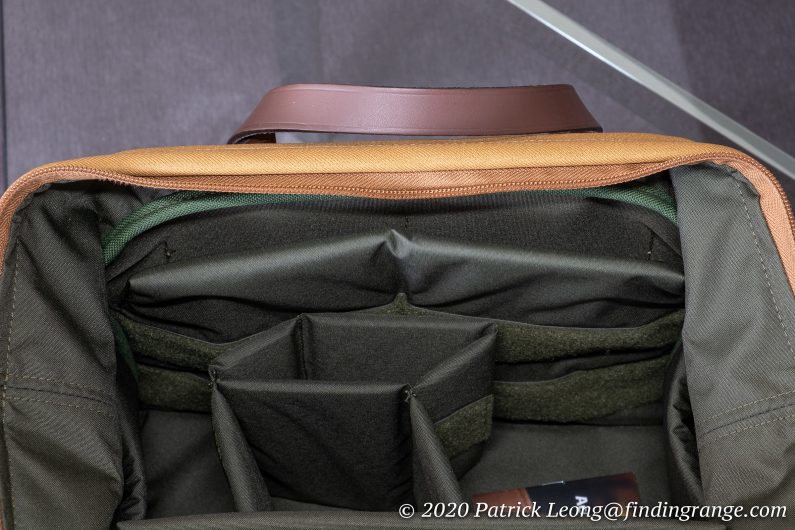
↑ There are two additional front pockets in the main compartment.
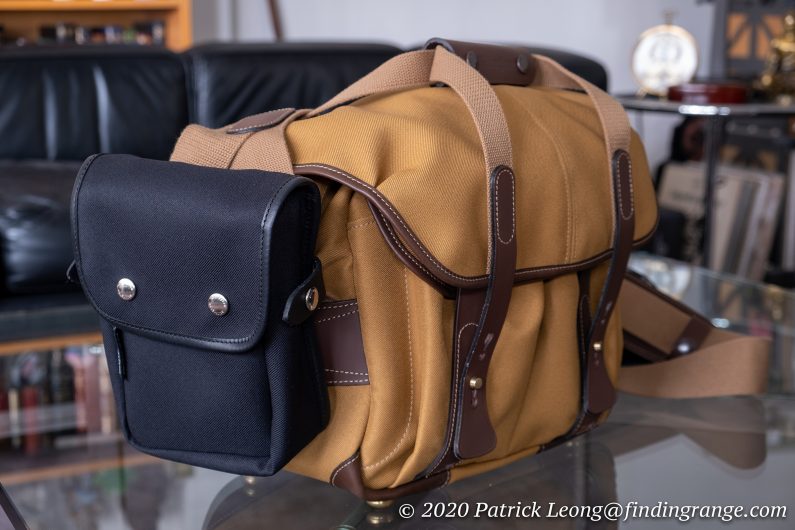
↑ You are able to use the Delta Pockets with this bag, if you need more space. The Delta Pocket in this photo is black because it’s the one I use for my 307. You can definitely get a matching color for your bag.
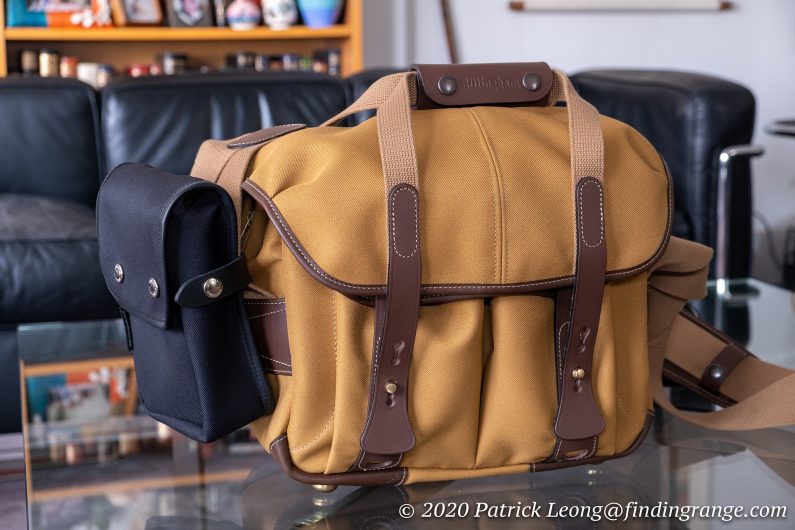
↑ Here’s another angle of the Delta Pocket attached to the Billingham 207.
Billingham 207 Camera Bag in Use:
The Billingham 207 is a large bag designed to hold some serious gear, so don’t expect it to feel like a small satchel or messenger bag. With that said, for a bag of this size, it’s quite comfortable to use. For instance, when the 207 is packed full, it can be a heavy bag, and often times, heavy bags have that rolling over feel. To combat this, the 207 has the inverted ‘Y’ shaped Delta Sling webbing at the shoulder strap’s fixing points, which helps prevent any tipping or rolling motion as you walk. This actually works quite well, especially when the bag is packed full.
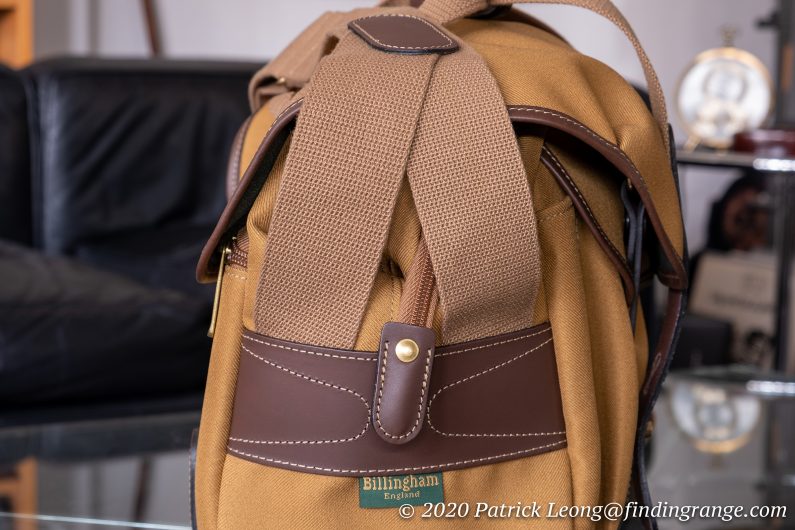
↑ The inverted ‘Y’ shaped Delta Sling webbing.
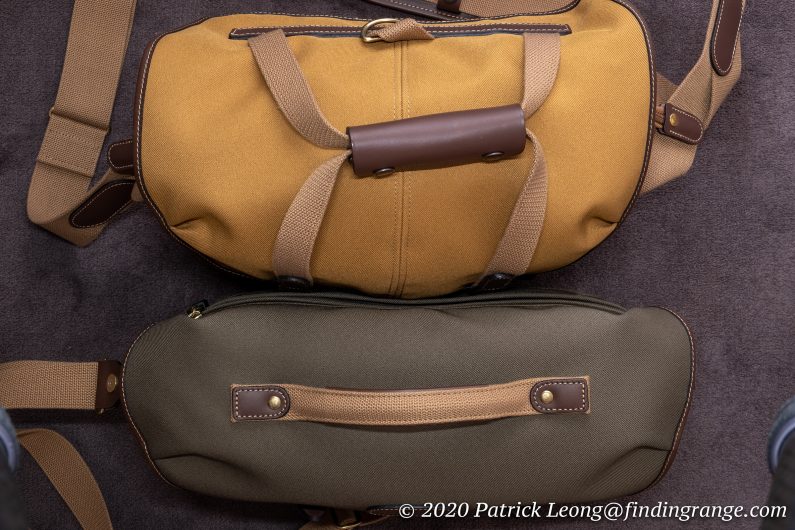
↑ This is just to give you an idea of size versus one of Billingham’s most popular bags: The Hadley Pro 2020.
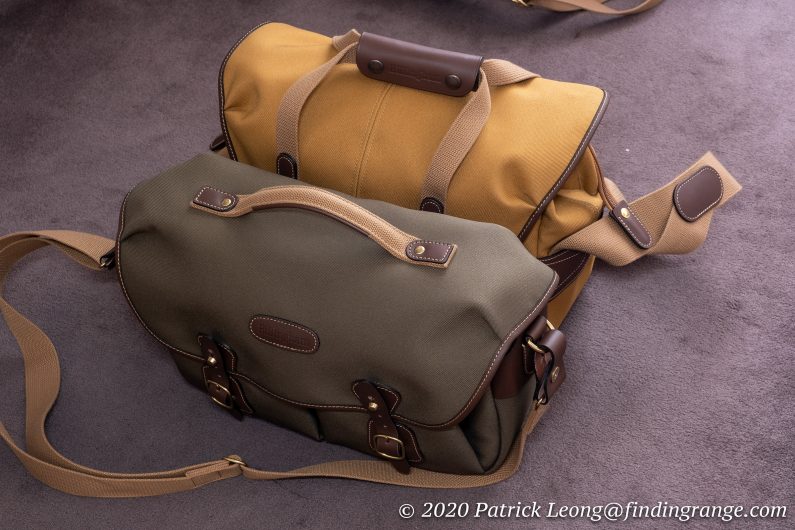
↑ Here’s another photo comparing the Billingham 207 and the Hadley Pro 2020.

↑ Here’s a photo comparing the 207 and 307.
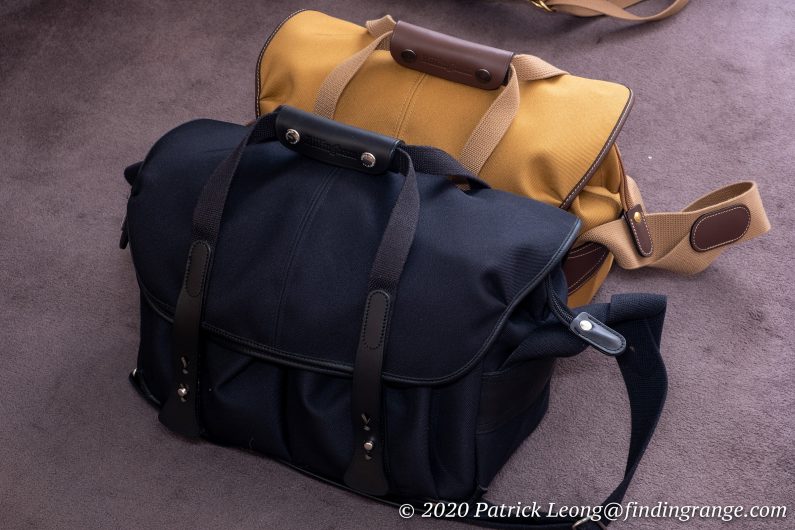
↑ Here’s another photo comparing the 207 and the 307.
Also, the 207 is the type of bag that retains its rectangular shape, especially since there’s that thick base on the bottom yet surprisingly, it still hugs the body quite well. I’ve been walking around NYC with it a lot during my time with it, and it doesn’t bounce around or feel unwieldy. It hugs me pretty well while I’m walking. Of course, a lot of this is thanks to that ‘Y’ shaped Delta Sling too.
What I also love about this bag in general is that it doesn’t feel like it’s dragging me down, if that makes sense, which is something I sometimes associate with larger bags simply because of the amount of gear they can carry. No matter how much I pack this bag, it can get heavy because of the amount of gear but it never has that dragging feeling.
Now, to combat the discomfort from the weight that you might be carrying with this bag, Billingham has included its SP50 Shoulder Pad, which is one of the best shoulder pads that you can buy. For one, craftsmanship, and the quality of materials are just as good as the bag itself. It’s also grippy, and the cushion has just about the perfect combination of softness and firmness. It really does help a lot when the bag is packed full.

↑ The SP50 Shoulder Pad is included with the Billingham 207.

↑ The bottom of the shoulder pad.
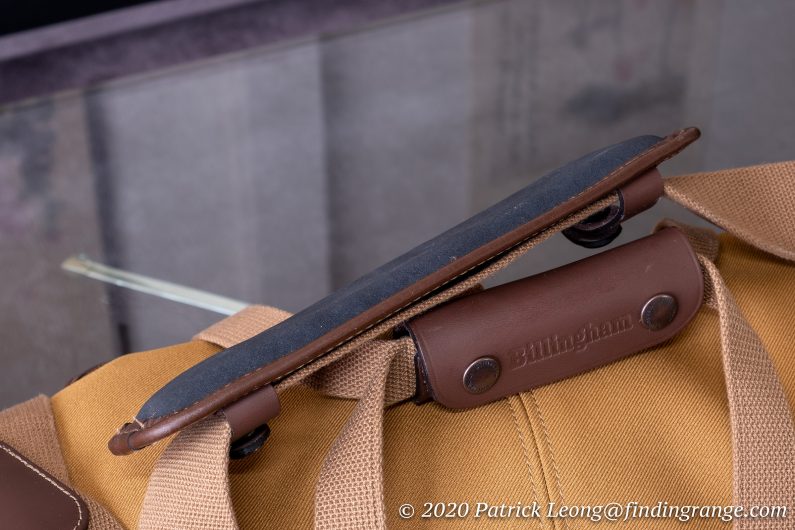
↑ Here’s another view of the shoulder pad.
Moreover, the 207 comes with two sets of top handles, which I already mentioned above but figured I’d mention again in this section. You get the one on top of the flap, and leather handles that are under the flap for moments when you want to move the bag quickly, and don’t want to go through the whole process of zipping up the main compartment, and securing the flap.
Lastly, the Billingham 207 (B&H Photo/Amazon) doesn’t seem to attract any unwanted attention while I’m walking around. You might get the attention of, “Wow, that person is carrying a large bag” haha, but it’s not the type where people think you’re carrying super expensive camera gear. This is what I’ve been experiencing around NYC, at least. Billingham bags in general, don’t really look like typical camera bags, which is a great thing. Even my own bag, which is the 307, doesn’t draw any unwanted attention or second glances, and that’s not only bigger than the 207, it’s currently one of Billingham’s largest.
Billingham 207 Camera Bag Specifications:
External Dimensions
W350mm (13¾”) x D210mm (8¼”) x H300mm (11⅞”)
Internal Dimensions
W320mm (12⅝”) x D150mm (5⅞”) x H220mm (8⅝”) Main compartment
Capacity
10 litres (0.35 feet³)
Weight
1.75 kgs (3.86 lbs)
Front external ‘dump’ pockets (x2): W110mm (4⅜”) x D50mm (2”) x H210mm (8¼”)
Capacity (each) 0.75 litres (0.03 feet³)
Front and rear internal pockets (2 front, 2 rear): W130mm (5⅛”) x D Nominal x H240mm (9½”)
Capacity (each) Nominal
Rear zipped pocket: W280mm (11”) x D Nominal x H170mm (6¾”)
Capacity Nominal
Shoulder Sling Measurements
Length: can be adjusted between 1120mm (44⅛”) and 1610mm (63⅜”) approx.
Width: 50mm (2″).
Billingham 207 Camera Bag Verdict:
If you’re looking to carry more gear or just larger gear in general, the Billingham 207 is a fantastic bag to consider. It has so much going for it. Of course, quality doesn’t always come cheap. The price for one of these bags is anywhere from $399 to $449 depending on the color. Still, I don’t even feel it’s that expensive, considering what you’re getting here, and when you compare it to other high end camera bags. Here’s why.
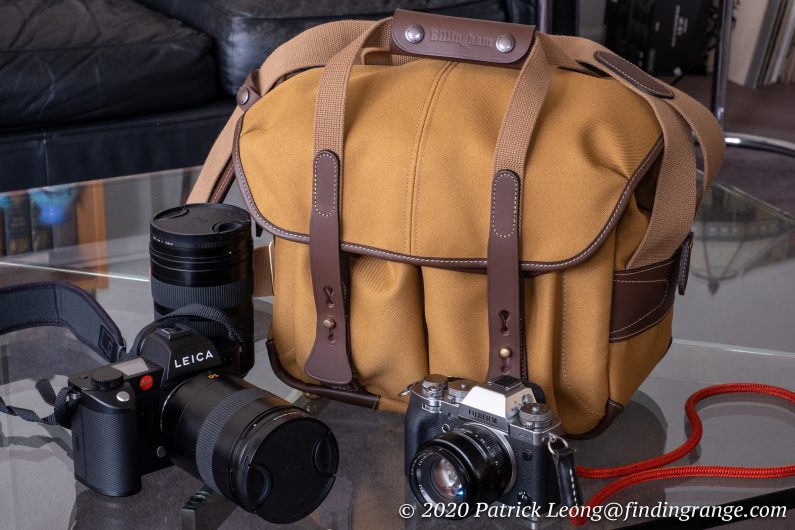
↑ The Billingham 207 with the Leica SL2 and the Fuji X-T3.
The 207 is a Billingham, so the quality is second to none. I’ve reviewed nearly the entire Billingham range, and as I mentioned earlier, I own quite a few too. All the materials used and superb craftsmanship here combine to create a bag that offers the user some of the best protection that you can get for gear. I seriously mean it. The Billingham 207 (B&H Photo/Amazon) not only has some of the best padding in the industry to protect against bumps, scrapes, and even some impact, it also has some of the best weather protection out there. Bottom line is this bag can rough it with the best of them all while protecting your, often times, expensive gear. Furthermore, the 207 will last you years and years, so in the end, it definitely comes out cheaper than buying multiple bags. Since this is a review sample, I obviously have not had the chance to use the 207 for months, and months but I have owned a 307 for about a year and a half already, and it has been one of my most dependable bags. It is also my most used bag now.
There are bags out there that are more expensive, and cheaper as well but in the end, I feel the 207, as a whole, is hard to beat. This is really one of the most impressive bags that I’ve had the pleasure of reviewing, which is why I highly recommend it to anyone who needs a larger bag to carry there gear.
If you want more info on the Billingham 207, check out Billingham’s official site!

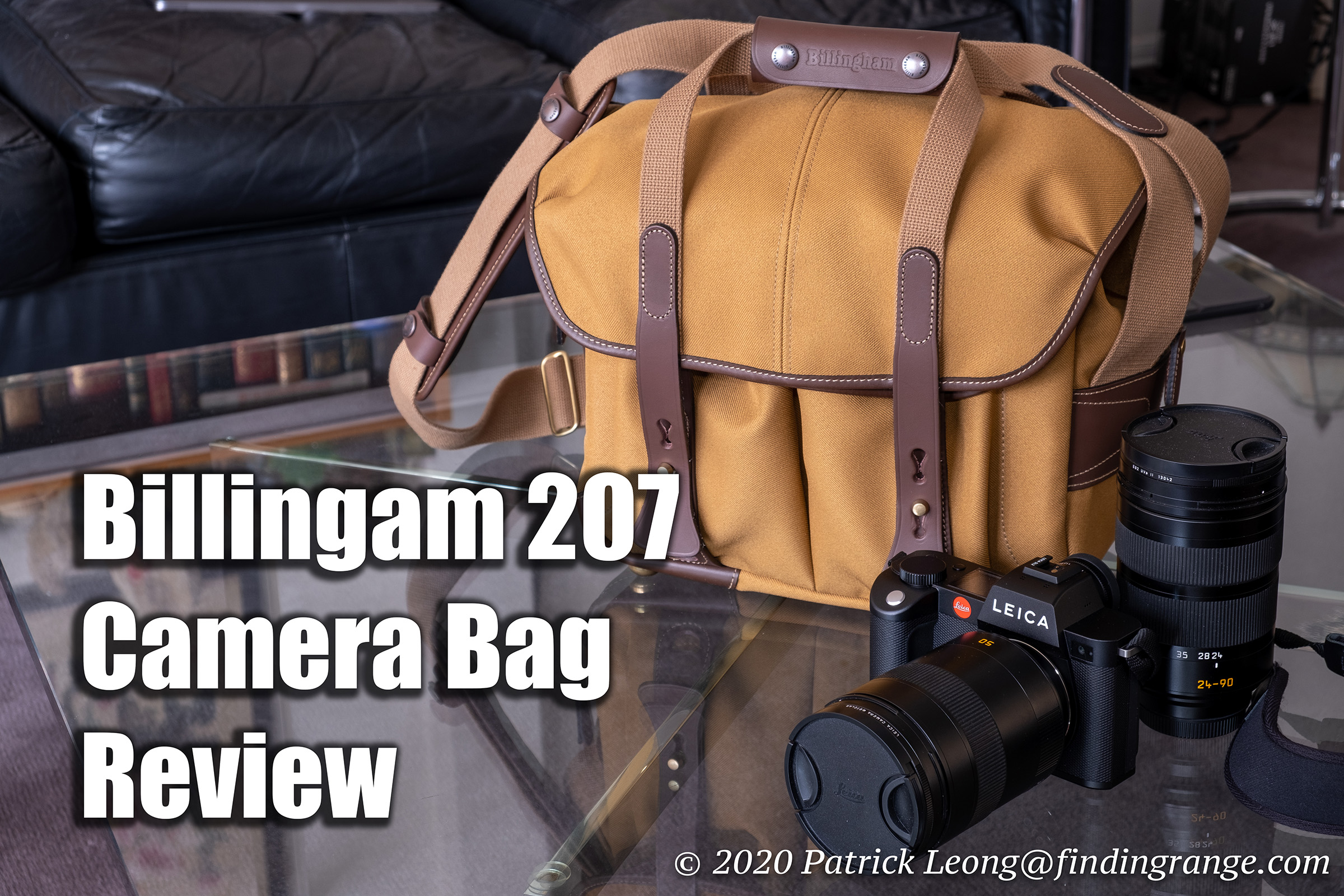
Thanks for your detailed review! I owned the 207 but gave it not so many chances as too big in certain occasions and too small in others.
Now, I’m considering the 307 or, as an alternative, the 335 as they provide a larger base than the, for example, Hadley large pro. This will enable me to pack my gear horizontally and have it accessible without removing some stuff.
Based on your experience any suggestion between the 307 and the 335? Secondly, Being aware that fully loaded a shoulder bag is less comfortable than a backpack, would you still suggest/use a 307/335 over a backpack? Thanks a lot for your time and support!
Dante
Hi Dante,
Thanks for taking the time to read it! Apologies for the late reply; been updating my site in the background, and it’s been a bit hectic.
I prefer the 307. The doctor’s bag style opening makes it very convenient. It’s a lot easier to pull out gear, especially larger pieces.
My 307 is my “daily user” now, and has been for a long time. I love the bag. However, I do have a bad back, and there was a time when my back was not doing great, and I decided to add the Billingham Rucksack to my collection. It is much better when you’re carrying heavy gear, so if you’re looking for more comfort, the backpack is a great idea. The 307 is a big, heavy bag when its packed full, and it’s not the bag’s fault; it’s designed for that kind of gear. But it’s a shoulder bag. With that said, I’ve always been a shoulder bag kind of guy, so even though I did get the backpack, I went back to my 307 :).
If you have any other questions, feel free to ask! Greatly appreciate you stopping by,
Best,
Patrick